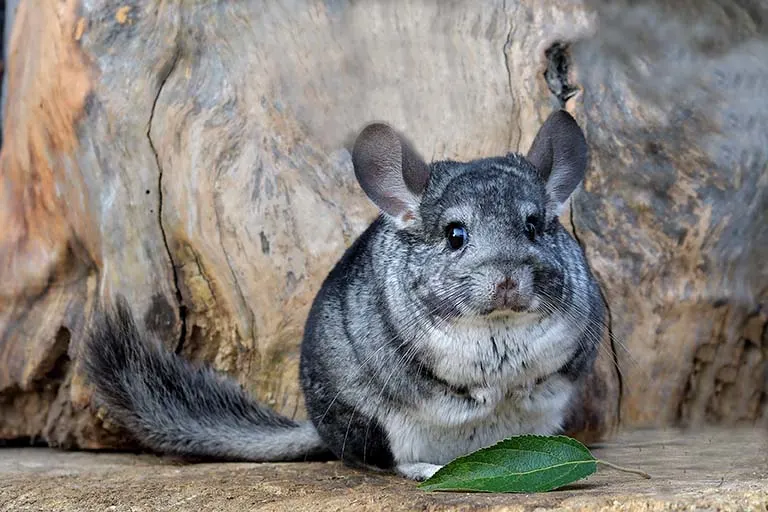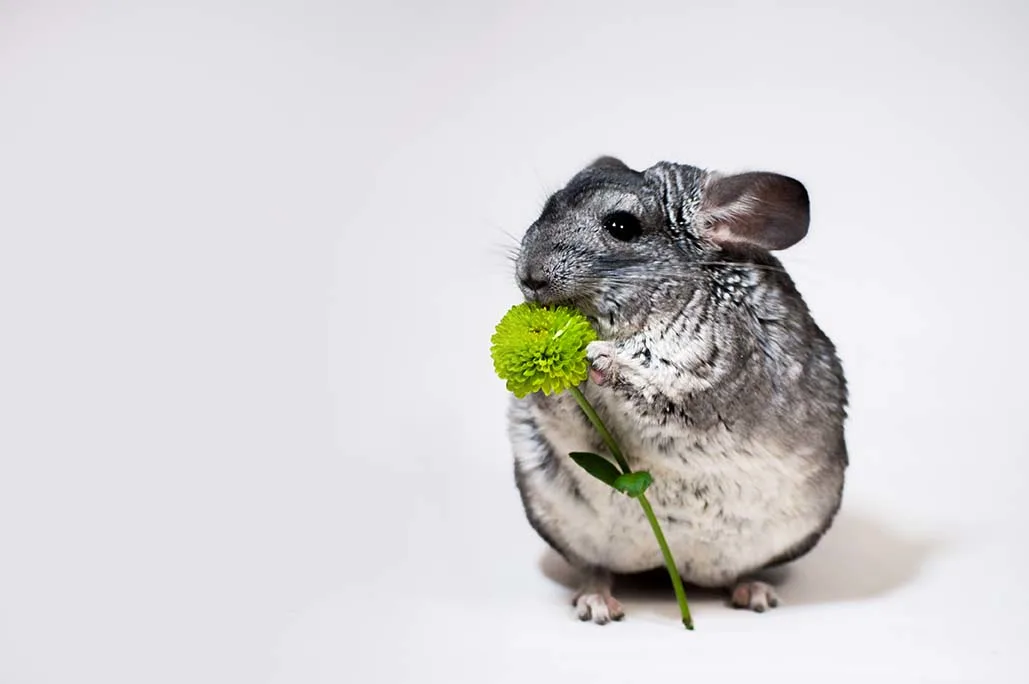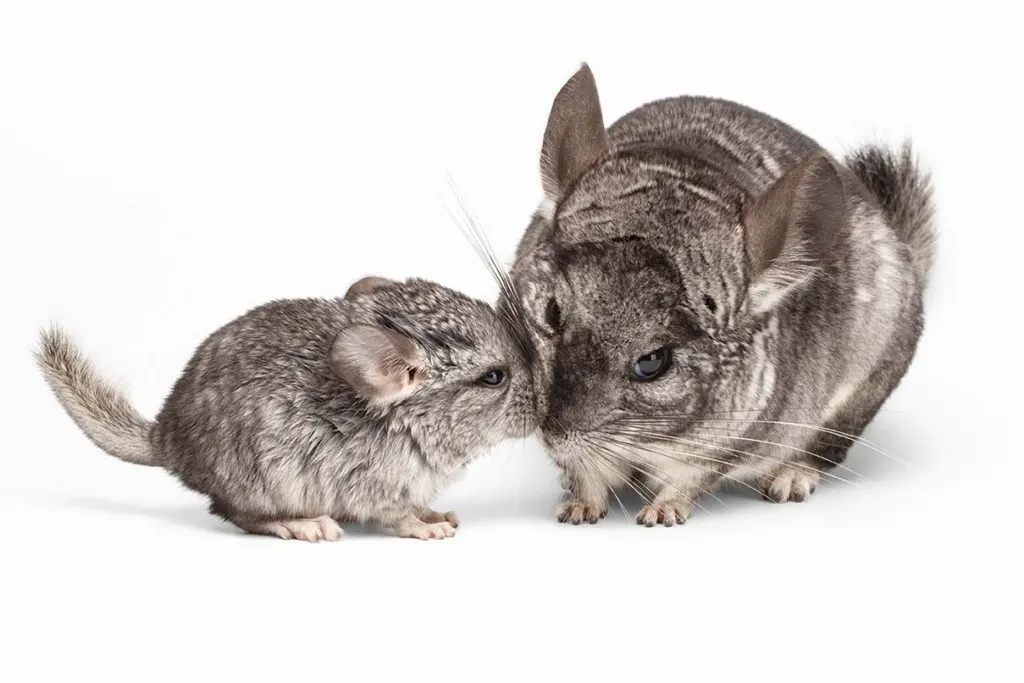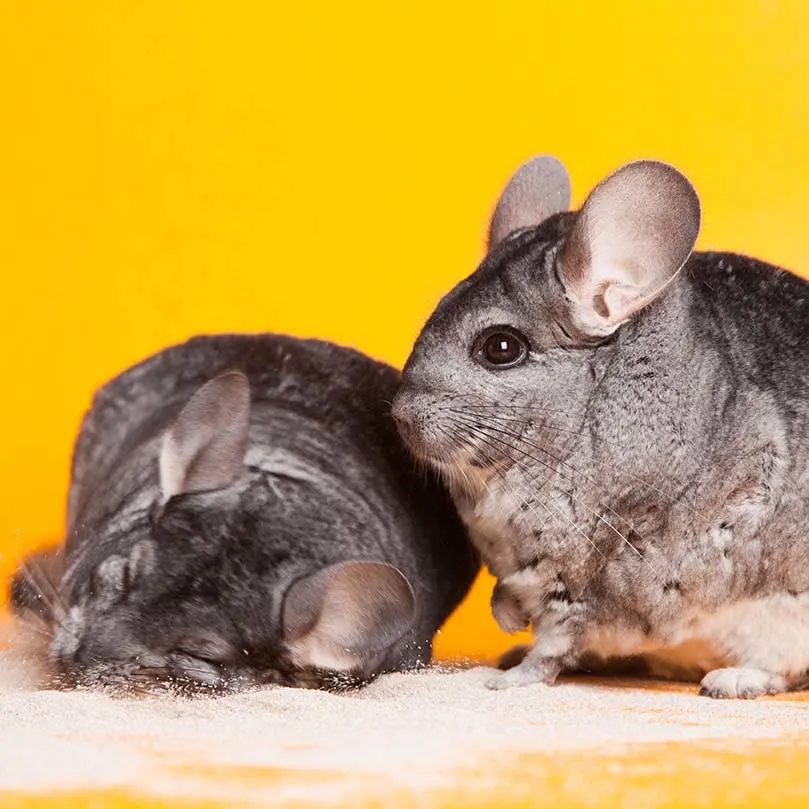Discover all kinds of interesting information in this chinchilla facts for kids article.

Chinchillas are rodents that are native to the Andes Mountains of northern Chile. Chinchillas were almost driven to extinction due to the demand for their luxurious soft fur. Today, they’re often kept as pets.
Physical Description
Historically, wild chinchilla fur was mottled yellow-gray in the wild. Selective breeding, however, has led to other colors becoming common, including silver, yellow-gray, bluish-gray, white, beige and black. Each hair ends in a black tip, no matter what color the chinchilla is.
Chinchillas have short forelimbs and long, muscular hind legs with four toes on each foot. Each toe has a thin claw. They resemble rabbits, but their ears are much shorter and rounder. Chinchillas have large, black eyes and bushy tails.
They are typically 9 to 15 inches (23 to 38 centimeters) long, but the tail can add another 3 to 6 inches (8 to 15 cm) to their length. They generally weigh 1.1 to 1.8 lbs. (0.5 to 0.8 kilograms).
Habitat
In the Andes, chinchillas can live in elevations of about 9,800 to 16,400 feet (3,000 to 5,000 meters). At those heights, it can be very cold; 23 degrees Fahrenheit (minus 5 degrees C) is the average minimum temperature in some places. This is why chinchillas have developed such thick fur, to help them tolerate freezing temperatures.
They burrow underground tunnels or nestle in rock crevasses to make their homes. They are highly social and live in colonies that consist of hundreds of chinchillas.

Female chinchillas are often aggressive toward other females. When ready to mate, they can also be aggressive toward males. Females are primarily monogamous which means they only have one mate for life. Males, on the other hand, can have many female mates.
Habits
Chinchillas are largely nocturnal so will be most active at night. Sometimes they are called crepuscular, meaning their activity peaks at dawn and dusk. Chinchillas are active and playful and thrive when they have a consistent routine.
Diet
Chinchillas are omnivores. This means they eat both plants and meat. They eat almost any vegetation including grasses and herbs. They also eat seeds.

Additionally, they eat insects and bird eggs when available. To eat, they sit up on their hind legs and hold their food in their front paws to nibble on it. In dry climates, chinchillas will find water from morning dew and the flesh and fruit of cacti.
Offspring
The breeding season for chinchillas runs from November to May in the Northern Hemisphere and from May to November in the Southern Hemisphere.
A pregnant chinchilla will carry her young for about 111 days before giving birth. Females have babies twice a year. Each time they give birth, they will have one to six babies. These groups of babies are called litters and the individual babies are called kits.

Unlike most rodents which are born without fur and are helpless, kits are born with hair and with their eyes open and functioning. Newborn kits even have teeth. They weigh only 1.2 ounces (35 grams).
Although they are able to digest solid foods, the kits nurse for six to eight weeks. Kits seek warmth and will crawl under their mother for protection. Their mother’s clean them regularly. At about 8 months old, the babies are ready to have offspring of their own.
Classification/Taxonomy
Kingdom: Animalia
Phylum: Chordata
Subphylum: Vertebrata
Class: Mammalia
Order: Rodentia
Family: Chinchillidae
Genus: Chinchilla
Species: There are two species of chinchillas: Chinchilla chinchilla (short-tailed chinchilla), Chinchilla lanigera (long-tailed chinchilla)
Chinchillas are related to guinea pigs and porcupines.
History
Chinchillas first appeared around 41 million years ago. The chinchilla's ancestors were some of the first rodents in South America. Chinchilla fur became popular in the 1700s and were hunted to near extinction by 1900. About that time, Argentina, Bolivia, Chile and Peru banned the hunting of wild chinchillas.
An American mining engineer named Mathias F. Chapman got special permission from the Chilean government to bring chinchillas to the United States in 1923. Almost every pet chinchilla in the United States today is a direct descendant of the 11 chinchillas that Chapman brought to the country.
Predators
Chinchillas have many predators. Owls and hawks are an example of some of the wild chinchilla's predators, which fly and hunt chinchillas from above. Snakes are also a predator to the chinchillas. A snake can sneak up on a chinchilla from behind or from below in snake holes. Foxes, mountain lions and cougars are also predators of the chinchilla.

A chinchilla’s instinct is to run and hide when it senses danger. Chinchillas are small enough to hide under logs, within bushes or burrow underground to get away from predators. They are also capable of clinging to tree trunks and rocks as well as jumping and leaping.
Lifespan
In general, chinchillas live eight to 10 years. However, some have lived as long as 20 years.
25 Unusual Facts about Chinchillas
- With gentle handling from a young age, most chinchillas can become quite tame and bond with their owners.
- Chinchillas cannot survive in temperatures higher than 80 F (27 C). High temperatures and humidity can cause them to suffer from heat stroke.
- Many chinchillas are bred commercially for their fur. The Convention on International Trade in Endangered Species has restricted the sale and trade of wild chinchillas since 1975.
- Both species of chinchilla are on the International Union for Conservation of Nature and Natural Resources' endangered-species list. Both the short-tailed chinchilla and the long-tailed chinchilla are listed as critically endangered.
- Domesticated chinchillas should be kept in a wire mesh cage with a solid floor. It should be well ventilated and kept dry and cool in temperatures from 60 to 70 F (16 to 21 C). Chinchillas should be kept in individual cages as they do not get along well when caged together.
- To stay clean, these rodents give themselves dust baths.
- Chinchillas are thought to be smarter than rabbits and can be taught to play with humans. However, they are hyperactive and high-strung so should not be given as a pet to small children.
- Despite having the densest fur of all land mammals, they can have around 50 to 75 individual hairs growing out of a single hair follicle. Chinchilla fur is extremely soft to the touch.
- Their incredibly dense fur protects them from skin parasites and fleas. However, fleas and ticks can still make their way in spots where the fur is thinner, such as the belly, face, ears, and feet.
- Chinchillas can shed large patches of fur to break free from the grasp of their predators. This is called “fur slipping.” They may also do this when they’re stressed, held too tightly, or get stuck.
- Their dense fur traps their body heat, which can lead to overheating when placed in warmer environments.
- Chinchillas can be especially caring, even adopting abandoned or orphaned baby chinchillas. Unlike other rodents, the male chinchillas also participate in caring for the young.
- Chinchillas are quite social. They like playing with other chinchillas and enjoy foraging together. Often, a few chinchillas stand guard and watch for predators as the others forage.
- Chinchillas communicate primarily through sound. They make a wide range of sounds such as chirping and soft cooing.
- Between male and female chinchillas, females are larger, heavier, and more dominant than the males.
- Their large ears provide chinchillas with sensitive hearing that lets them detect predators easily.
- Unlike in rats where males are easily distinguishable from females, both male and female chinchillas have cone-like external genitals.
- Chinchillas have sensitive whiskers, similar to cats, that they use to navigate in the dark.
- Chinchillas can jump as high as six feet (1.8 m) thanks to their powerful hind legs.
- Though rare, chinchillas can experience convulsions or sudden and intense involuntary movements. These convulsions may indicate brain damage, nutrient deficiency, or hemorrhaging. This can also happen after mating, and indicates circulatory problems. They can also get convulsions due to stress in extreme cases.
- In 2016, their populations experienced a small recovery, going from “critically endangered” to “endangered”.
- Chinchillas are very inquisitive and love to explore their surroundings.
- Similar to rabbits, chinchillas perform a behavior called cecotrophy, which means they ingest specific droppings in order to ensure they get the required level of nutrition from their food.
- While they don’t typically run, a chinchilla can run up to 15 mph (24 km/h) to escape a predator.
- Chinchilla teeth continually grow throughout their lifespan. For domesticated chinchillas, this means they require ongoing dental care.
You don't want to miss learning about these cool mammals.
